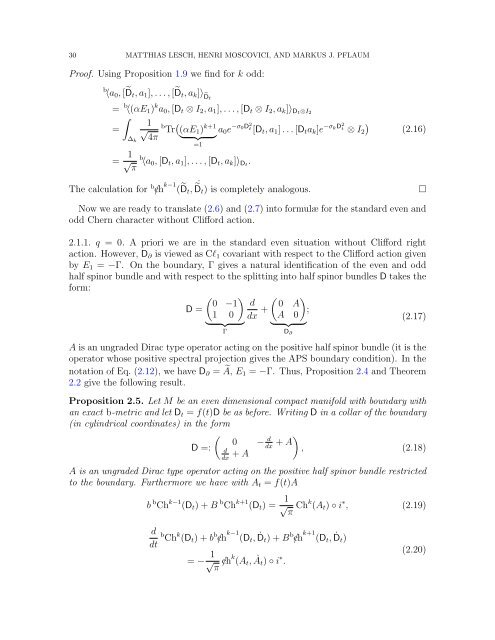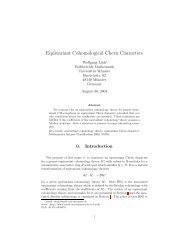Connes-Chern Character for Manifolds with Boundary and ETA ...
Connes-Chern Character for Manifolds with Boundary and ETA ...
Connes-Chern Character for Manifolds with Boundary and ETA ...
You also want an ePaper? Increase the reach of your titles
YUMPU automatically turns print PDFs into web optimized ePapers that Google loves.
30 MATTHIAS LESCH, HENRI MOSCOVICI, AND MARKUS J. PFLAUM<br />
Proof. Using Proposition 1.9 we find <strong>for</strong> k odd:<br />
b 〈a 0 , [˜D t , a 1 ], . . . , [˜D t , a k ]〉 eDt<br />
= b 〈(αE 1 ) k a 0 , [D t ⊗ I 2 , a 1 ], . . . , [D t ⊗ I 2 , a k ]〉 Dt⊗I2<br />
∫<br />
1<br />
= √ b Tr ( )<br />
(αE 1 ) k+1 a<br />
∆ k 4π } {{ } 0 e −σ 0D 2 t [Dt , a 1 ] . . . [D t a k ]e −σ kD 2 t ⊗ I2<br />
=1<br />
= √ 1 b 〈a 0 , [D t , a 1 ], . . . , [D t , a k ]〉 Dt .<br />
π<br />
The calculation <strong>for</strong> b /ch k−1 (˜D t , ˙ ˜D t ) is completely analogous.<br />
(2.16)<br />
□<br />
Now we are ready to translate (2.6) <strong>and</strong> (2.7) into <strong>for</strong>mulæ <strong>for</strong> the st<strong>and</strong>ard even <strong>and</strong><br />
odd <strong>Chern</strong> character <strong>with</strong>out Clif<strong>for</strong>d action.<br />
2.1.1. q = 0. A priori we are in the st<strong>and</strong>ard even situation <strong>with</strong>out Clif<strong>for</strong>d right<br />
action. However, D ∂ is viewed as Cl 1 covariant <strong>with</strong> respect to the Clif<strong>for</strong>d action given<br />
by E 1 = −Γ. On the boundary, Γ gives a natural identification of the even <strong>and</strong> odd<br />
half spinor bundle <strong>and</strong> <strong>with</strong> respect to the splitting into half spinor bundles D takes the<br />
<strong>for</strong>m:<br />
( ) ( )<br />
0 −1 d 0 A<br />
D =<br />
1 0 dx + A 0<br />
(2.17)<br />
} {{ } } {{ }<br />
Γ<br />
D ∂<br />
;<br />
A is an ungraded Dirac type operator acting on the positive half spinor bundle (it is the<br />
operator whose positive spectral projection gives the APS boundary condition). In the<br />
notation of Eq. (2.12), we have D ∂ = Ã, E 1 = −Γ. Thus, Proposition 2.4 <strong>and</strong> Theorem<br />
2.2 give the following result.<br />
Proposition 2.5. Let M be an even dimensional compact manifold <strong>with</strong> boundary <strong>with</strong><br />
an exact b-metric <strong>and</strong> let D t = f(t)D be as be<strong>for</strong>e. Writing D in a collar of the boundary<br />
(in cylindrical coordinates) in the <strong>for</strong>m<br />
(<br />
0 −<br />
d<br />
D =:<br />
+ A<br />
)<br />
dx<br />
d<br />
+ A , (2.18)<br />
dx<br />
A is an ungraded Dirac type operator acting on the positive half spinor bundle restricted<br />
to the boundary. Furthermore we have <strong>with</strong> A t = f(t)A<br />
b b Ch k−1 (D t ) + B b Ch k+1 (D t ) = 1 √ π<br />
Ch k (A t ) ◦ i ∗ , (2.19)<br />
d b Ch k (D t ) + b b /ch k−1 (D t ,<br />
dt<br />
Ḋt) + B b /ch k+1 (D t , Ḋt)<br />
= −√ 1 /ch k (A t , A ˙ t ) ◦ i ∗ .<br />
π<br />
(2.20)

















